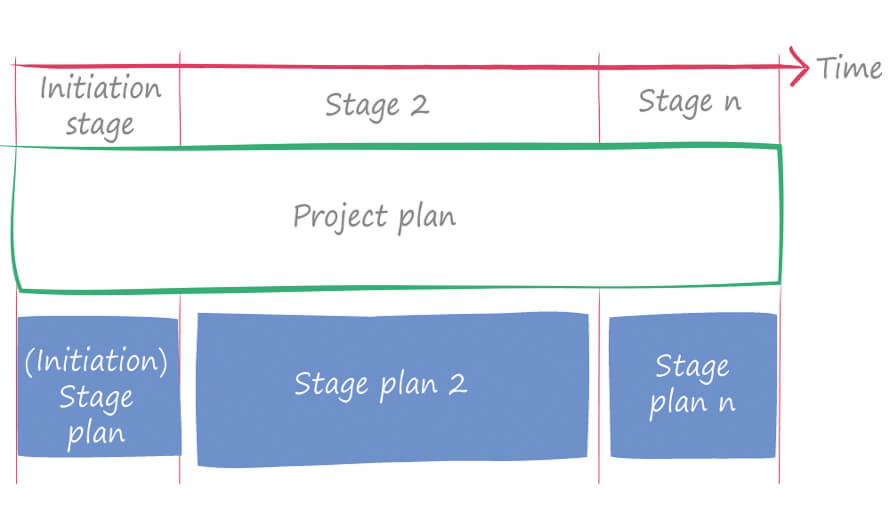
Manage by stages principle
PRINCE2 is a principles-based project management methodology. There are 7 principles which form the foundation stones of the method and everything in PRINCE2 is based upon them.
One of the principles is known as the ‘manage by stages’ principle. If you are not applying this principle on your project, it means your project is not a PRINCE2 project.
You can learn more about the principles of PRINCE2 by taking either a classroom PRINCE2 course, or a PRINCE2 course online.
So, what is the rationale behind this principle? Let us explain.
Management stages
A PRINCE2 stage is also known as a management stage. PRINCE2 management stages are a way of breaking down a project into smaller, more manageable chunks. The minimum number of PRINCE2 stages on a project is two.
Don’t confuse PRINCE2 stages with phases. They are two different things. People often use phases on projects to delineate different specialist work on a project. For example, analysis, design, build, test, deploy. PRINCE2 stages, as you will below form key decision points about whether to proceed with or stop the project.
PRINCE2 stages can coincide with the start or end of a technical phase, and they can also straddle multiple phases. Similarly, one technical phase might contain multiple PRINCE2 stages.
The key thing to understand is that technical phases are driven by the technical nature of the work, whereas PRINCE2 stages are driven by the needs of the project’s decision-makers, and the level of risk on a project.
Initiation stage
The first PRINCE2 stage on a project has a special name. It is called the initiation stage. It occurs when starting up a project. As its name implies, it is where the project gets initiated.
Initiation is where the project manager develops a project plan and detailed business case justifying the investment in the project. During initiation the project manager also prepares strategies for managing quality, risk, issues, changes, sustainability, commercial, communication, and benefits. All this documentation is brought together into one collection known as the project initiation documentation (PID).
Planning the next stage
The project manager also prepares a more detailed plan for the next management stage. This shows all the work for the next PRINCE2 stage, the timescales and costs, the outputs, and required resources. This is known as the next stage plan.
The project’s main decision-makers (the project board) then uses the PID and the next stage plan to decide whether to proceed to the next PRINCE2 stage. If the project board decides the project is worth the costs, timescales, and risks, then they can approve the PID and next stage plan and commit the resources necessary to implement the next PRINCE2 stage.
Something similar occurs at the end of every subsequent management stage, except for the final stage. When the final management stage is reached, this is where the project will close, and so there is no need to create another stage plan because there will be no more stages.
When taking this decision, if the project is not worthwhile, the project board will stop the project. There will be no more work done except to close the project and salvage anything of value from the work done so far.

The diagram above shows the breakdown of a project into multiple PRINCE2 project stages (the red vertical lines). There is one high-level project plan covering the whole project, and more detailed stage plans – one for each stage.
Decision gate
The end of each PRINCE2 project management stage is thus a decision gate. The project board decides either to approve the next stage and commit resources to implement it, or it decides to close the project and save the organisation the time, money and resources that was originally planned for the project. A PRINCE2 stage thus forms a ‘stop/proceed’ decision.
In this way, PRINCE2 project stages are a less risky approach to taking investment decisions than one big decision taken at the start of the project. In PRINCE2, decisions to ‘stop or proceed’ are taken at the end of all PRINCE 2 stages.
How long are PRINCE2 stages?
The length of a PRINCE2 stage depends upon many different factors but includes the following.
Level of risk
The greater the level of uncertainty, the shorter the number of PRINCE2 stages. The riskier the project, the more stages are required. That’s because the project board need to take its ‘stop/proceed’ decisions more frequently to mitigate the risk.
Planning horizon
It is only possible to plan so far into the future in detail before planning becomes a waste of time. This is known as a ‘planning horizon’. Planning for the future beyond what is realistic is only going to mean the plan will fail because it becomes harder to predict what will happen the further in the future you try to do this.
Since the project plan is a high-level plan, the stage plan acts as the detailed plan for each PRINCE2 stage. This covers all the work of the stage. It is this plan that the project approves when it commits to fund the next stage. Therefore, the stage plan must only try to plan for what is a reasonable time in the future. This is the duration of the next PRINCE2 stage.
Availability of the project board
The members of the project board are senior managers busy with lots of things, other than a single project. Therefore, their availability becomes a limiting factor in when a PRINCE2 stage boundary occurs.
Organizational or programme needs
Sometimes it makes sense to coincide PRINCE2 stages with external events, such as the start or end of the financial year, when planning for the funding of the next years’ projects might take place. Similarly, if a project is part of a programme, it makes sense that PRINCE2 stages coincides with the major decisions of the programme.
PRINCE2 project lifecycle PDF
You can download a PDF version of the PRINCE2 project lifecycle showing how the PRINCE2 processes occur within each management stage.








